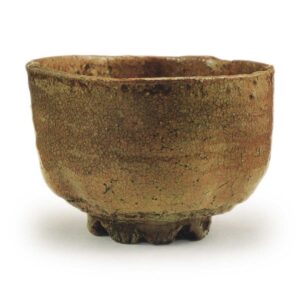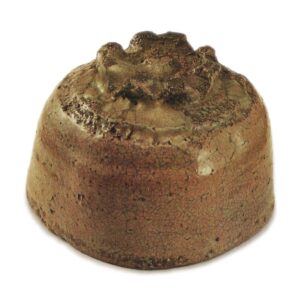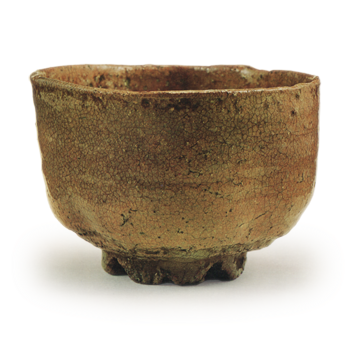

Height: 9.0-9.3cm
Diameter: 13.0-13.8cm
Outer diameter of foot ring: 6.3-6.5cm
Height of foot ring: 1.3cm
Hagi ware has long been considered the second most important type of tea bowl after Raku, and the most important of the national wares, and this is probably because it is a type of bowl that is full of the spirit of tea, and has won the popularity of tea masters.
Like the Kyushu kilns, Hagi ware was also created by potters from that region who were brought back to Japan after the Korean campaign and naturalized, and the original founders of Hagi ware were the Korean potters Ri Shakko and Ri Kei, who were brought back to Japan by Mori Terumoto in 1593. Lee Kei later took the name Saka Koraizaemon and built a kiln in the Matsumoto Nakanokura area of Hagi, and this was the first generation of Matsumoto Hagi ware. Lee Shakko’s grandson, the third generation Yamamura Heishiro Mitsutoshi, opened a kiln in Fukagawa Sannose and began making Fukagawa Hagi ware. In other words, there are two types of Hagi ware: the Matsumoto Hagi of the Lee Kei lineage, and the Fukagawa Hagi of the Lee Shaku-ko lineage, and both continue to flourish today.
Hagi ware was the official pottery of the Mori clan, and was mainly used for tea ceremony utensils, but the early pieces were generally copies of Korean wares, especially copies of Ido, Kohiki, Hakeme and Mishima wares. However, gradually, pieces with a Japanese feel were made, and although this “Miyoshino” tea bowl still has a Korean feel to its style, it also reflects a strong Japanese influence in its expression, in accordance with the tea ceremony. Judging from the style of the ware and the glaze, it is thought to be a Matsumoto Hagi, but the name “Miyoshino” was probably given in reference to the overall reddish beauty of the tea bowl.
The bold construction, with its prominent wheel marks, is particularly impressive, especially the bold scraping and imposing foot ring, which give the piece a bold and powerful feel. The foot ring is a typical example of the so-called cherry blossom foot ring (so-called because of its shape), which is a characteristic of the Ko-Hagi style and was designed based on the Korean-style split foot ring. Compared to the formalized, light and delicate style of the cherry blossom foot ring, it is full of a bold and dignified atmosphere. The inside of the high-fired glaze is a total glaze, with a strong helmet-shaped handle and a strong stand, but the exposed clay is red clay. The well-like, large and small crackled loquat-colored glaze is beautifully applied both inside and out, and the reddish color of the clay beautifully reflects in the glaze, adding a special touch of tea flavor. From the side of the foot ring to the inside, the glaze has accumulated in the grooves of the foot ring and is white, creating a pattern resembling the skin of a Japanese apricot, and when combined with the cherry blossom foot ring, it creates a magnificent tea-like atmosphere.
The shape is originally half-cylindrical, but the four corners are pressed and smoothed with the fingers, and the inside of the bowl is bulging where the fingers were pressed. The tea pool is shaped like a swastika. There are small dots scattered on the inside and outside of the glaze, and there is also a blue change, which together form a kind of scenery.
Accessories:
Inner box, paulownia wood, black lacquer, gold powder lettering on the lid, “Miyoshino” by Sakon Kuwayama
Bottom paper (Minami Mitsui family), “This tea bowl has been in the collection of our family since ancient times, and it is recorded in the Hagi ware catalogues of the time. was made by Koreyama Zaemon, and is commonly known as Sakura Kodaido, named after the shape of the cherry blossoms on the bottom. The way the four sides are formed is different, and it is admired for its shape.
Outside box: “Inside box inscription, written by Kuwayama Sakon” written on the inside of the lid.
It is known that it was passed down to the Mitsui family in the south, but the details of the rest are unknown.



